Oral language, Letter knowledge
Children will understand basic information, including the meaning of several novel words, presented in a book read aloud. Children will also identify the name and sound of the letter K.


New:
Be Prepared: This is the first of three repeated readings of a book with children. Today’s reading focuses on children’s understanding of basic information presented in the book. In advance of the session, identify all novel words in the book you intend to define for children across three days of reading the book. Select one or two important words to define for children today, especially words that are essential to understanding the book.See the Language/Literacy section of the Language/Literacy section of the ELM User Guide: 3–5 Years for additional information. Write the following at the top of the chart paper: Words We Understand.
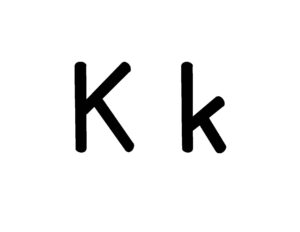 [Display letter K card.]
[Display letter K card.]
The word “kick” begins and ends with this letter. What is the name of this letter?
Letter K says /k/, just like in the word “kick.” /k/, /k/, kick. Let’s together say /k/, /k/, kick.
Who would like to tell us another word that begins with the letter K?
Now let’s read a book!
[See Week 3, Day 1 of Language/Literacy for a description and examples of how to approach today’s book reading. Key aspects are summarized below:
Number knowledge
Children will understand uses of addition.


Review:

One Is a Snail, Ten is a Crab by April Pulley Sayre and Jeff Sayre
Be Prepared: Organize a simple, two-column chart as shown. Include a cutout of a toy animal and a cutout of a toy car.
We are learning about adding and subtracting. What happens to our group when we add more items? (it gets larger)
[Display prepared chart and point to its parts as you describe them.]
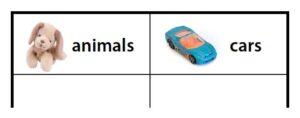
Today we will use a chart to help us find out how many toys are in a group. Our chart for today has two columns.
We will count how many toy animals are in a group and how many toy cars are in a group. Then we will add to see how many toys we have all together.
[Place three toy animals and four toy cars on the floor where all children can see them. Count each group of toys as you put a tally mark under animals or cars.]
Let’s count the number of toy animals in our animal group. I will write the total number next to the word “animals.”
[Lead children in counting the tally marks for animals by touching each mark as you count. Write below the tally marks the numeral that represents the number of tally marks in the “animals” section.]
Now let’s count the number of toy cars in our car group. I will write the total number next to the word “cars.”
[Lead children in counting the tally marks for cars by touching each mark as you count. Write below the tally marks the numeral that represents the number of tally marks in the “cars” section.]
We know that we have three toy animals in our animal group and four toy cars in our car group.
How can we find out how many toy animals and toy cars we have all together? (add together the number of animals and the number of cars)
We can add by counting on. Let’s start with the biggest group. The toy car group has four. Four is bigger than three. Let’s count on as we begin with the toy car group: 4, 5, 6, 7.
[Point to each tally mark as you count on.]
How many animals and cars do we have all together? (seven)
[Continue practice with adding using different numbers of animals and cars as time permits.]
Today we practiced adding by counting on. We added together the number of toy animals and the number of toy cars.
Extra support
Invite children who are learning to count a group of items to help you point to and count each group of tally marks.
Enrichment
Ask children if they can tell which group has more or fewer by looking at the tally marks.
Provide a collection of dominoes in a basket. Invite children to choose one domino at a time and add together the dots on both halves of the domino.
Add groups of boys and girls in children’s families. Add the totals together to find out how many people are in each family. Example: “Julia’s family has two boys and three girls. How many people are in her family all together?”
Executive function
Children will regulate their behaviors in response to changes in aural and visual prompts.


Review:
Be Prepared: Suggested song with both fast and slow tempos: “Bop ‘Til You Drop” on Greg and Steve’s Kids in Action CD. Two copies of four different large shape cutouts are needed. Place four different shape cutouts in classroom locations that can accommodate a brief large gathering of children. The remaining four different cutouts will be used by you during the activity.
If time permits, offer Orange Circle, Purple Circle from Week 33, Day 1 as a second game. If the game described below is too challenging for a majority of children, stop at an appropriate place and offer Orange Circle, Purple Circle from Week 33, Day 1. The game for today may be less challenging when offered again at a later point.
Today we will play a game we’ve played before. When we play this game, we freeze! We know that when we freeze, we stop what we are doing and hold our body in the position it is in.
How do we play The Freeze Game?
When we played this game before, we danced quickly to fast music and slowly to slow music. When the music stopped, we did whatever I did. Today we are going to play the game a different way.
I have placed four shapes around the classroom. Let me show you.
[Show children where each shape is located in the classroom. Invite children to name the shape and its characteristics as you point to it.]
When we play the game today, we will dance quickly to fast music and slowly to slow music. When the music stops, freeze and look at me. I will hold up a shape. When you see the shape I am holding up, find the same shape in the classroom and go stand by that shape. Let’s try it.
[Play a fast song and encourage children to dance quickly. Then play a slow song and encourage children to dance slowly. Intermittently turn off the music and encourage children to freeze in place. Hold up one of the four shapes and encourage children to find the same shape in the room and stand by it. Once all children are standing by the shape, invite them to gather as a group and try it again. Continue as long as time permits with the remaining three shapes.]
Today we played The Freeze Game again. We paid close attention to what we were expected to do and remembered new rules.
Extra support
Omit one or more of the shapes if children seem overly challenged.
As always, if children continue an action after it is to change or stop, gently remind them of the procedures by demonstrating what is to be done. You might wish to position yourself near children who find it challenging to regulate their behavior during the game.
Enrichment
If children readily stand next to the appropriate shape in the classroom, invite children to try a rule change. When the music stops, encourage children to stand next to a shape cutout in the classroom that is different than the shape you are holding.
Invite children to continue playing The Freeze Game. Provide music and encourage children to take turns turning the music on and off.
Send the new game rules home with children and encourage them to explain the new rules to family members at pickup time. Invite families to play at home.
Knowledge of habitats
Children will understand basic characteristics of a mountain habitat, including plants that live on a mountain.

*4 pictures as shown (1 shown in Enrichment tip)
Printables provided

New:
Review:

How Mountains Are Made by Kathleen Weidner Zoehfeld
We are learning about different kinds of habitats. We know that a habitat is a place where certain types of plants and animals usually live. Today we will learn about a mount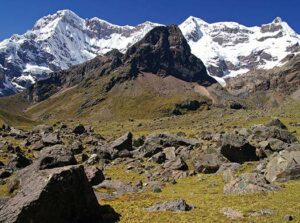 ain habitat.
ain habitat.
[Display picture of mountain.]
[Encourage children to discuss what they know about mountains.]
A mountain is a very high piece of land. A mountain is taller than anything else on the earth. The top of a mountain is called a peak. Usually it is very cold and windy near the peak of a mountain. Mountains also have many rocks. It can be difficult for things to grow and live on a mountain because of the cold, wind, and rocks.
Animals and plants that live and grow on a mountain have special ways of living in cold, windy, and rocky places.
[Display picture of mountain plants.]
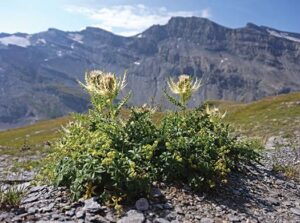
Here is a picture of plants that live high on a mountain. The plants are growing close to the ground. The plants are not tall.
What might happen to a tall plant when there are really strong winds? (get blown over, move around a lot)
Growing close to the ground can protect a plant from being hurt by strong winds.
Several months ago we grew bean plants in our classroom.
Did we put our bean seeds in soil or in rocks? (soil)
The soil helped our seeds grow into plants. The soil gave our seeds nutrients and a place for roots to grow. Remember, a nutrient is something that helps a living thing to grow. The soil was a home for the seed and the roots that grew out of the seed.
Sometimes there is a good home for seeds to grow in the soil between rocks. Sometimes there also is soil in the cracks of rocks. Seeds can be protected in the soil found around rocks.
[Display picture of a plant growing out of a crack in a rock.]
Here is a picture of a plant growing out of a crack in a rock. There is soil in the crack that helps a seed grow roots and become a plant.
The roots of plants that grow between rocks need to grow deep to find water in the soil. The water does not stay near a plant that grows between rocks. The water is deep in the soil.
Today we learned that a mountain is a very high piece of land. Plants and animals can be found in a mountain habitat. Many plants that grow in a rocky mountain need to grow deep roots to find water.
Extra support
Remind children that dirt is another word for soil.
Provide pictures taken of the classroom’s growing bean plants if children need a visual reminder of the planting activity. Remind children that the bean seeds needed soil and water to grow.
Enrichment
Display the picture of a rock garden. How would a rock garden be similar to a mountain? (rocky, little soil)
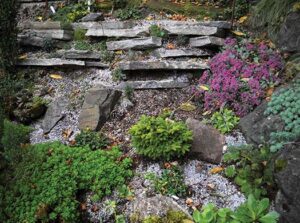
Encourage children to share pictures from home they may have of mountains or a mountainous place they have visited or lived.
Place several small rocks and small artificial plants in the block center. Encourage children to use their imagination to build a mountain habitat using the blocks, rocks, and plants.
There may be plants (weeds) growing out of cracks in street or sidewalk pavement near your home. Explain to children that this arrangement is similar to how plants grow between rocks on a mountain.